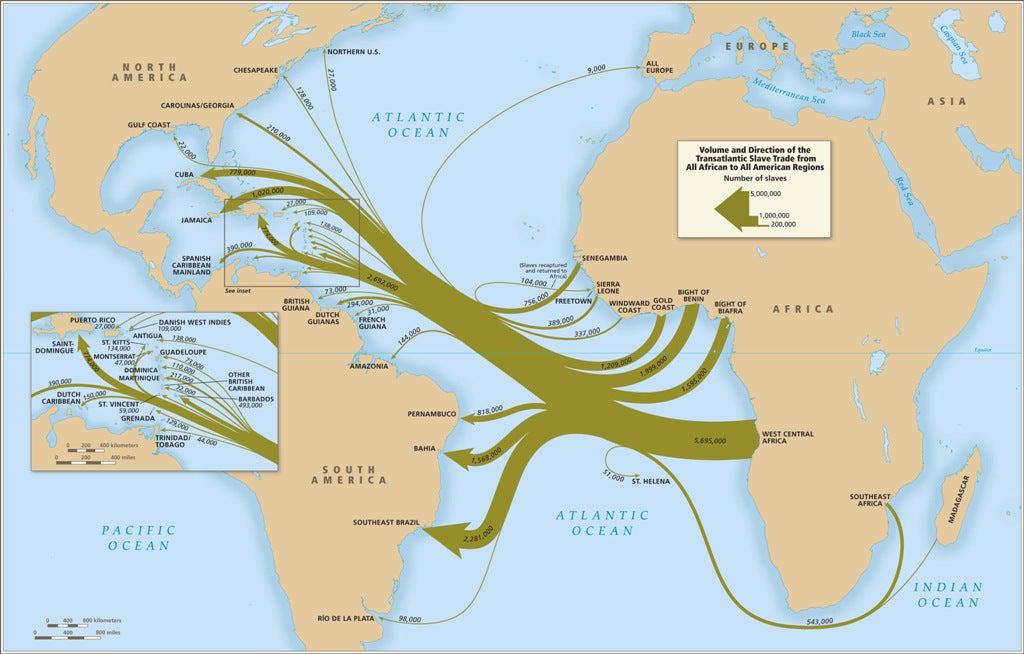African Slave Trade Map


David Chen
Data Visualization Specialist
David Chen is an expert in transforming complex geographic datasets into compelling visual narratives. He combines his background in computer science ...
Geographic Analysis
What This Map Shows
The African Slave Trade Map highlights the routes and regions involved in the transatlantic slave trade from the 16th to the 19th centuries. This visualization details the departure points in Africa, the Middle Passage across the Atlantic Ocean, and the destinations in the Americas and the Caribbean. It illustrates not only the geographic dimensions of this tragic chapter in history but also the enormity of human suffering associated with it. This map serves as a stark reminder of the scale of the slave trade and its lasting impacts on societies across continents.
Deep Dive into the African Slave Trade
The transatlantic slave trade was a significant and dark aspect of global history, involving the forced transportation of millions of Africans to the Americas. It is estimated that between 12 million and 12.8 million Africans were shipped across the Atlantic, with around 10.7 million surviving the grueling journey. The routes depicted on the map reflect the complex network of trade, highlighting key ports in West Africa, such as Goree Island and Elmina, which were pivotal in this tragic commerce.
What's fascinating is that the slave trade was not a singular event but a series of interconnected activities that spanned centuries. The demand for labor in the Americas, particularly in the sugar and cotton plantations, fueled this inhumane trade. The Middle Passage, the journey from Africa to the Americas, was notorious for its brutality. Captives were crammed into ships under horrendous conditions, with many succumbing to disease, malnutrition, or violence.
Interestingly, the map also reflects the demographic impact on African societies. Regions such as present-day Angola and Nigeria were heavily affected, losing a significant portion of their population to the slave trade. The effects were not just immediate; the long-term consequences can still be felt today in the cultural, social, and economic fabric of African nations. The displacement and suffering of millions contributed to a demographic shift that altered the course of African history and its relationship with the wider world.
Regional Analysis
Examining the map regionally reveals stark contrasts in involvement and impact. For instance, the Bight of Benin and the Bight of Biafra were major sources of enslaved people, while the Gold Coast (now Ghana) was primarily focused on gold and other resources. Each region had its unique interactions with European traders, shaped by local politics, economic conditions, and the sociocultural landscape.
In West Africa, kingdoms like Dahomey and Ashanti engaged in the slave trade, often capturing individuals from rival groups to meet the European demand. In contrast, regions less involved in the trade, such as East Africa, saw a different set of circumstances. The Omani Empire was active in the slave trade, but the routes and dynamics there differed significantly from those in West Africa. For example, the Swahili Coast experienced a different kind of slave trade, with a focus on the Indian Ocean, which included the export of enslaved people to the Middle East and the islands of the Indian Ocean.
The map also allows us to observe the geographic spread of enslaved Africans in the Americas. Brazil received the largest number of enslaved people, followed by the Caribbean, particularly places like Jamaica and Cuba. The United States, while receiving a smaller total, was significantly impacted in states like Virginia and South Carolina, where plantation economies flourished.
Significance and Impact
Understanding the African Slave Trade is crucial, not just as a historical event, but for its ongoing implications in contemporary society. The legacy of the slave trade is visible in the cultural diversity of the Americas, the social structures within African nations, and the ongoing struggles against racism and inequality.
Today, discussions around reparations and the acknowledgment of historical injustices are increasingly relevant. The impacts of this trade are not confined to the past; they resonate in modern-day social and economic disparities. Have you noticed that discussions about racial equality and justice often reference this historical context? The map serves as a necessary tool for education and reflection, providing a visual representation of past atrocities that must not be forgotten.
As we move forward, understanding the complexities of the African Slave Trade and its routes allows us to engage in meaningful conversations about race, identity, and history. It also encourages us to reflect on how we can ensure that such human rights violations never occur again.
Visualization Details
- Published
- October 18, 2025
- Views
- 24
Comments
Loading comments...